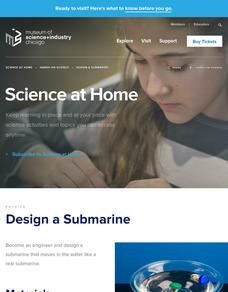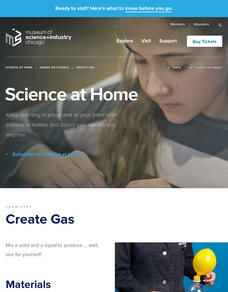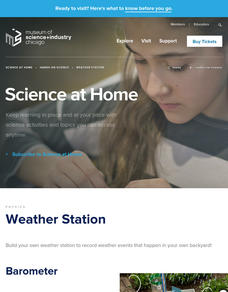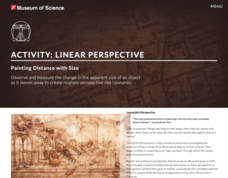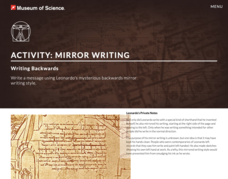Museum of Science
Slime
Let knowledge of polymers and slime ooze into one's brain. Scholars learn about polymers and cross-linking by conducting a fun hands-on activity. They create their own colorful slime by mixing a borax solution and a glue solution.
Museum of Science
Egg Bungee
Think bungee jumping looks scary? Knowing the science behind bungee jumping might make it less so. Using an egg and rubber bands, young engineers model bungee jumping. They test the distances that the egg falls for different numbers of...
Museum of Science
Cloud in a Bottle
Perhaps one day humans will learn to control the weather. Future scientists simulate clouds and fog in a plastic bottle. They conduct an experiment where they place smoke and hot water in the bottle, then squeeze and release repeatedly....
Museum of Science
Elephant Toothpaste
Get a surprised reaction from trying out the chemical reaction. Scholars conduct a chemical experiment by adding yeast to hydrogen peroxide and dish soap in a plastic bottle. They learn that yeast contains a catalase enzyme that releases...
Museum of Science
Fingerprints
Capture your unique print. Individuals ink a finger and create a print on a deflated balloon. By blowing up the balloon, pupils get a magnified view of their unique print. They see if they can identify any loops, whorls, and arches in...
Museum of Science
Design a Submarine
Don't just sink the boat. Using a closed container as a submarine, pupils experiment to see what to add to the container to make it float, sink to the bottom, and hover in the middle. After finding one option, learners see if they can...
Museum of Science
Hot Air Balloon
It is more than just blowing hot air. Pupils first build a hot air balloon out of tissue paper by cutting enough panels of tissue paper to form a balloon shape and glue the panels together. Using a hot air gun, individuals then inflate...
Museum of Science
Create Gas
Let's have a gas. Individuals mix baking soda and vinegar in a bottle. Learners view the interaction between the solid and the liquid and notice that a gas is formed. Scholars notice the gas inflates a balloon stretched across the mouth...
Museum of Science
Worm Farm
It is not a barrel of monkeys—it's a jar of worms! Scholars create a worm farm in a spaghetti sauce jar. Pupils layer moist soil, sand, and oatmeal to create a habitat for worms. Individuals place worms into the habitat, cover it with...
Museum of Science
Wind Turbine
Let the energy blow. Using mostly easily found material such as PVC pipe and fans, pupils build wind turbines. Scholars connect a multimeter to an electric motor to determine the amount of energy generated by their designs. Learners then...
Museum of Science
Strawberry DNA
Humans aren't the only ones with DNA—fruit has it too. Using a extraction solution, pupils pull the DNA out of a piece of fruit. Learners crush up a piece of fruit with the solution and filter out the solids. Scholars then add cold...
Museum of Science
Cup Drop
Create egg drop soup. Teachers first set up eggs that are held up above cups of water with a piece of cardboard and cardboard tubes. Learners try to determine a way to get the eggs to drop into the cups. Using a broom, the instructor...
Museum of Science
Comeback Can
Convert energy within a can. Learners build a can that suspends a weight inside the can via a rubber band. The pupils roll the can away from them as the rubber band wraps around itself. The force of the band unwinding brings the can back...
Museum of Science
Candy Chromatography
Don't play favorites when separating candy colors. Pupils use the process of chromatography to separate the colors of two different types of candy-coated candies. Class members compare their results to an unknown sample to determine...
Museum of Science
Circuit Board
Light up the solutions. By following a set of directions, pupils build a circuit board with six different circuits. Learners use the circuit board to create a matching activity by connecting the questions to the correct answers via a...
Museum of Science
Weather Station
Find out what it is like outside before braving the elements. Teachers follow directions to build a barometer, rain gauge, and anemometer. Class members use the built weather instruments along with a thermometer to record weather...
Museum of Science
Water Balloon Catapult
Fire away! Using a couple of milk jugs, a dowel rod, and a yardstick, individuals build catapults to throw water balloons. Learners notice that the catapult is a simple machine. By making a target, the class has a chance to refine their...
Museum of Science
Straw Bridges
There is never a bridge too far. Using common items, class members build bridges to span an opening. Pupils test different geometric shapes to determine which is the strongest. Learners use pennies to find the strength of their bridges...
Museum of Science
Virtual Heart
No more beating the pavement to find a virtual model of the human heart. See one in continual real-time motion, and layer it to highlight electrical impulses, blood flow, and valve activity.
Museum of Science
Linear Perspective: Painting Distance with Size
Young scholars examine a simple set up to measure the change in the apparent size of an object as it moves away from them.
Museum of Science
Open Window: Using Leonardo's Perspectograph
Students look through one eye and trace the outlines of objects seen through a window to create a drawing with natural and correct perspective.
Museum of Science
Mirror Writing: Writing Backwards
Learners experiment with writing backwards as Leonardo DiVinci did.
Museum of Science
Gadget Anatomy: Understanding Machines
Students observe a machine closely from several angles while it operates. Identify the elements of machines combined in different gadgets. Create a clear diagram of how a machine works.
Museum of Science
Museum of Science: Welcome to Exploring Leonardo
At this resource, learn all about Leonardo da Vinci. Visuals of his work, ideas for activities and investigation. Additional links and lesson ideas for teachers.







